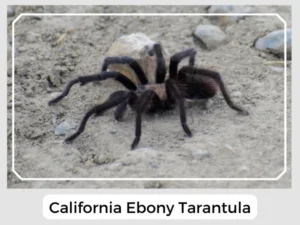The California ebony tarantula is a fascinating spider mainly seen in California. With a close relative named the Texas brown tarantula, these spiders have their own unique characteristics. In this post, we’ll share some cool facts about them for you to discover.
Female tarantulas lay their eggs inside a silk case for protection.
The spiderlings are greyish-white, eventually molting into adults.
As these spiders have poor eyesight, they rely on the silk threads produced by them in their webbing to detect prey and other objects in their surroundings.
Yes, California Ebony Tarantulas have venom, but it’s mild and not harmful to humans. It helps them catch their prey.
These tarantulas are docile, generally not biting anything other than their prey. However, due to possessing large fangs, any bite inflicted can be painful.
The California ebony tarantula is a crucial component of the desert ecosystem. As a predator, it helps regulate populations of insects and other small animals, ensuring a balanced food web.
Natural Predator: Predators of this species include birds of prey, coyotes, and other larger mammals that inhabit the same desert regions.
Prey-Predator Dynamics: These tarantulas maintain insect populations by preying on beetles, cockroaches, crickets, grasshoppers, and mantises. Conversely, they serve as a food source for their natural predators, contributing to the biodiversity and energy flow within their habitats.
Relationship with Humans: Interactions between California ebony tarantulas and humans are minimal, and while they have venom, it is not potent enough to be harmful to humans. These tarantulas are known for their docile nature and are unlikely to bite unless provoked.
| Lifespan | Males: 8–12 years, Females: 25 years |
| Distribution | The United States, mainly California as well as Arizona, Nevada, and Oregon |
| Habitat | Deserts |
| Diet | Beetles, cockroaches, crickets, grasshoppers, and mantises |

In summary, the California ebony tarantula is an essential player in its desert habitat, performing vital ecological functions through its predatory behavior.
The California ebony tarantula is a fascinating spider mainly seen in California. With a close relative named the Texas brown tarantula, these spiders have their own unique characteristics. In this post, we’ll share some cool facts about them for you to discover.
Female tarantulas lay their eggs inside a silk case for protection.
The spiderlings are greyish-white, eventually molting into adults.
As these spiders have poor eyesight, they rely on the silk threads produced by them in their webbing to detect prey and other objects in their surroundings.
Yes, California Ebony Tarantulas have venom, but it’s mild and not harmful to humans. It helps them catch their prey.
These tarantulas are docile, generally not biting anything other than their prey. However, due to possessing large fangs, any bite inflicted can be painful.
The California ebony tarantula is a crucial component of the desert ecosystem. As a predator, it helps regulate populations of insects and other small animals, ensuring a balanced food web.
Natural Predator: Predators of this species include birds of prey, coyotes, and other larger mammals that inhabit the same desert regions.
Prey-Predator Dynamics: These tarantulas maintain insect populations by preying on beetles, cockroaches, crickets, grasshoppers, and mantises. Conversely, they serve as a food source for their natural predators, contributing to the biodiversity and energy flow within their habitats.
Relationship with Humans: Interactions between California ebony tarantulas and humans are minimal, and while they have venom, it is not potent enough to be harmful to humans. These tarantulas are known for their docile nature and are unlikely to bite unless provoked.
| Lifespan | Males: 8–12 years, Females: 25 years |
| Distribution | The United States, mainly California as well as Arizona, Nevada, and Oregon |
| Habitat | Deserts |
| Diet | Beetles, cockroaches, crickets, grasshoppers, and mantises |

In summary, the California ebony tarantula is an essential player in its desert habitat, performing vital ecological functions through its predatory behavior.